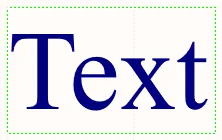Text strings are available for placement in the following ways.
From the schematic editor:
- Choose Home | Graphical Elements | Text String.

- Right-click in the design space then choose Place » Text String.
From the schematic library editor:
- Choose Home |Circuit & Graphical Elements | Text String.

- Right-click in the design space then choose Place » Text String.
After launching the command, the cursor will change to a cross-hair and you will enter text string placement mode. A text string will appear floating on the cursor.
- Position the object then click or press Enter to effect placement.
- Continue placing further text strings or right-click or press Esc to exit placement mode.
Additional actions that can be performed during placement while the text string is still floating on the cursor and before its left-hand edge is anchored are:
- Press the Tab key to pause the placement and access the Text String mode of the Inspector panel in which its properties can be changed on the fly. Click the design space pause button overlay (
 ) to resume placement.
) to resume placement.
- Press the Spacebar to rotate the text string counterclockwise or Shift+Spacebar for clockwise rotation. Rotation is in increments of 90°.
- Press the X or Y keys to mirror the symbol along the X-axis or Y-axis.
A newly-placed text string will initially have default text of Text. Change the text as required using one of the editing techniques described later in this document.
Graphical Editing
This method of editing allows you to select a placed text string object in the design space and graphically change its length, height or location.
When a text string object is selected, click and drag the editing handles to resize the text string.

A selected Text String
Click anywhere on the text string away from editing handles then drag to reposition it. While dragging, the text string can be rotated (Spacebar/Shift+Spacebar) or mirrored (X to mirror along the X-axis).
The name for the text string object can be edited in-place by:
- Single-click the text string to select it.
- Single-click again (or press Enter) to enter the in-place editing mode and enter the new name. Sufficient time between each click should be given to ensure the software does not interpret the two single-clicks as one double-click (which would open the Inspector panel).
- To finish editing, press Enter or use the mouse and click away from the text string.
To clear the selection of (or de-select) the object, use the Esc key.
Non-Graphical Editing
This method of editing uses the Inspector panel mode to modify the properties of a text string object.

During placement, the Text mode of the Inspector panel can be accessed by pressing the Tab key. Once the text string is placed, all options appear.
After placement, the Text mode of the Inspector panel can be accessed in one of the following ways:
- Double-click on the placed text string object.
- If the Inspector panel is already active, select the text string object, right-click then choose Properties from the context menu.
- With the text string selected, click View | Schematic | Inspector from the main ribbons.
Editing Multiple Objects
The Inspector panel supports multiple object editing in which the property settings that are identical in all currently selected objects may be modified. When multiples of the same object type are selected manually, an Inspector panel field entry that is not shown as an asterisk (*) may be edited for all selected objects.